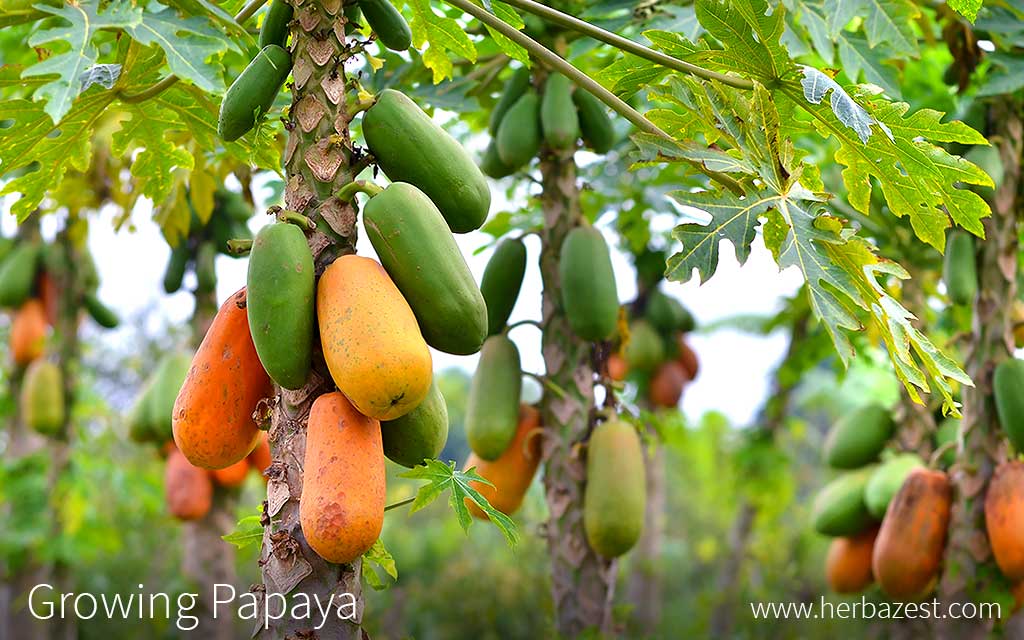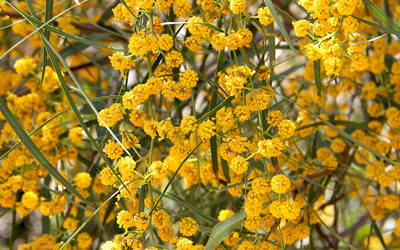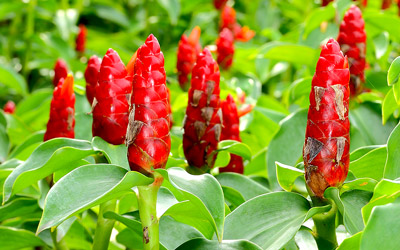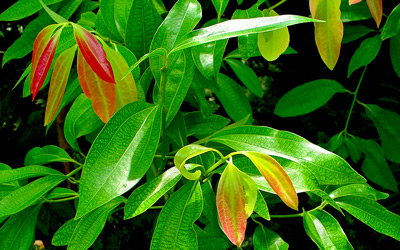The papaya plant has a complex system of reproduction and it may seems like a finicky, capricious little tree that does what it wants. However, as any other species, papaya depends on a variety of environmental factors to thrive, such as temperature, soil type, and irrigation. The following growing guidelines will help you to succeed in its cultivation.
1. Preparing the Soil
Papaya plants perform best in light, well-drained soils that are rich in organic matter, with a pH range of 5.5 - 6.5. However, the plant will also grow in various other soil types if given adequate care and attention.
So long as temperatures remain above 60°F (16°C), most sandy, loamy, and rocky soils help to support the health of the plant's root system, and are recommended for optimum papaya tree growing. Conversely, salty soils are not well-tolerated.
2. Planting
Planting Papaya Outdoors
In warm regions, papayas can be planted year-round, but mid to late summer seems to be the most viable timeline, considering most will set fruit within 10 - 12 months.
It should be noted that both seed germination and plant reproduction are extremely complex processes that befuddle many home growers. For one thing, the outer coating of papaya seeds prevents germination while they are still inside of the ripe fruits. To deactivate this natural mechanism, it is necessary to break the membrane, thoroughly clean the seeds, and let them air dry before planting.
Another way to prepare papaya seeds for planting consists of soaking them in water for three to four hours in order to increase the likelihood of seed viability. In any case, the seeds are extremely vulnerable in the early stages of papaya growth, and could potentially benefit from a light coating of fungicide prior to planting.
After following the above instructions for preparing the seeds, plant three to five seeds directly into outdoor mounds spaced about five feet (1.5 m) apart.
The ideal temperature for growing papaya trees is between 70 - 90F (21 - 32C). Anything higher may cause tree blossoms to fall prematurely, while anything cooler can threaten fruit development or prevent flowering altogether. A growing site in full sunshine is recommended because high winds and too much shade are also detrimental to fruit production.
In addition, the sex of papaya plants is determined by their genetic parents. They may be male, female, or hermaphroditic, which means they are self-pollinating or cross-pollinated via wind, insects, or human intervention. Unfortunately, because plant sex cannot be determined until flowering, it is recommended to plant several trees at once in order to ensure fruit production in at least one plant.
Planting Papaya Indoors
Although papaya plants do not respond all that well to transplanting, on some occasions, it may be necessary to start the papaya growing process indoors because of weather and other climatic concerns.
After preparing the seeds as noted above, plant about three to five seeds per one-gallon pot or container and place them in the warmest, sunniest location possible. Germination generally occurs within three or four weeks. Indoor papaya plants need to be thoroughly watered.
After the seedlings reach about 8 - 12 inches (20 - 30 cm) in height, identify the healthiest and most pervasive plant of each pot, snipping all others.
Deciding to grow papaya indoors is not without significant risks. Not only does transplanting increase the likelihood of root deformity and dehydration, but it may also result in a curved, unstable trunk. Therefore, the transplanting process should not be delayed once the papaya growing season has begun. Furthermore, choosing a suitable location for healthy papaya growing will ensure that it only has to be done once.
3. Plant Care
Throughout every stage of development, the following practices may also complement a healthy papaya growing regimen.
Watering
Growing papaya with adequate moisture levels is a delicate balancing act. On the one hand, dehydration and drought put unnecessary stress on a papaya plant, causing it to lose its leaves or produce dwarfed, bitter-tasting fruits. On the other hand, overwatering can lead to rotting, and periods of flooding for 48 hours or more will be fatal to these delicate plants.
For these reasons, papaya trees favor proper drainage and dryness, especially in the winter. While timed irrigation is ill-advised, watering every three to four days or when the soil feels dry is a good practice.
Fertilizing
Papayas perform well under the occasional application of very small quantities of light, organic fertilizers rich in nitrogen, magnesium, phosphate, and potash. Proper technique demands an even distribution over the entire root area.
When it comes to young papaya plants, quarter-pound applications of fertilizer once every two to three weeks are well tolerated. As they mature to eight or nine months of age, the budding papaya trees are fertilized with heavier applications of about two pounds every other month.
Pruning
Pruning is not generally a requirement for growing papayas, but dead leaf removal is a good habit because it helps to reduce the spread of pests and plant illnesses while also preventing unsightly scarring of the papaya fruit.
Weed Control
Sensible weeding and mulching can help to improve the soil and reduce problems from invasive species. Keep in mind that mulch retains soil moisture and will therefore prolong intervals between watering.
A four-inch (10-cm) layer of bark, woodchips, or other related material can be used for papaya trees, but only if maintained at a distance of one foot (30 cm) from the base of the tree trunk.
4. Pest & Disease Control
Outside of normal upkeep, papaya growers should observe the following cautions.
Pests
The wasp-like papaya fruit fly is the gravest papaya pest there is. By infesting the inner cavity, it successfully lays eggs inside of the fruit, and its squirmy offspring later emerge from the irrevocably destroyed peel. Infested fruit shows signs of yellowing and spotting before eventually dropping from the papaya tree.
Other major pests include the papaya webworm, the two-spotted mite, and the papaya whitefly, which feed off various other parts of the plant, including its leaves, roots, and stems. Seasoned growers have found that the best methods of defense include covering the newly-developed papaya fruits with paper bags and planting other insect-repelling crops to control the migration of these pests.
Diseases
Papaya ringspot virus (PRV) is the most redoubtable malady to ever plague the Carica papaya plant, laying waste to many papaya gardens worldwide. Early symptoms of the illness include yellowing and mottling of leaves, followed by reduced leaf growth, water-soaked spotting on the stems, and abnormally small, rotting fruits with acrid flavors.
Because PRV is a contagious and irreversible virus, all plants suspected of infection should be promptly removed, burned, or otherwise isolated. To control the incidence of disease, it is also recommended to plant new papaya trees every three or four years in landscapes that are far away from where curcubits - like watermelons and squash -are planted.
Nowadays, several strains of papaya have even been genetically engineered in order to enhance their resistance against papaya diseases.
Wildlife
The papaya tree can be affected by groundhogs, gophers, and some other rodents that occasionally may wreak havoc. However, damage can be successfully thwarted by installing wire baskets and other critter-proof contraptions. Additionally, the papaya's thick, trunk-like stem is highly susceptible to scarring and other injury by lawnmowers, weed eaters, and other gardening supplies.
5. Harvest
Papaya fruits are ready for harvest once they have reached the “color break” stage -when about a quarter of their outer surface is covered in yellow. Since they are usually firmly attached to the stem, a sharp knife can also be quite handy.
Within several markets, unripe, green papayas are commercially desired, and are therefore picked just prior color break. Meanwhile, home gardeners growing papaya for personal consumption can wait until the fruits have turned almost completely yellow, which ensures the highest possible content of fruit sugars.
With proper care and suitable weather conditions, many people have been able to grow papaya yields of between 60 - 80 pounds (27 - 36 kg) per tree within the first year.
6. Storage
Papayas grown for shipping and export are usually harvested early so that they can reach consumers fresh. These partially-ripe fruits are best stored at a temperature of between 50 - 55°F (10 - 13 °C) in 85% humidity. After two or three weeks, they are returned to room temperature to continue the ripening process.
Meanwhile, post-harvest storage of fully ripe papayas involves refrigeration of between 34 - 37°F (1 - 3°C), where the fruits will keep for up to a week. Storing them unwashed reduces the risk of mold and water-soaking caused by increased surface moisture.
Other options include canning, preserving, or dehydrating the papaya flesh to prolong its shelf life.





